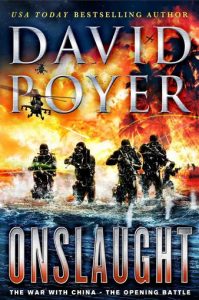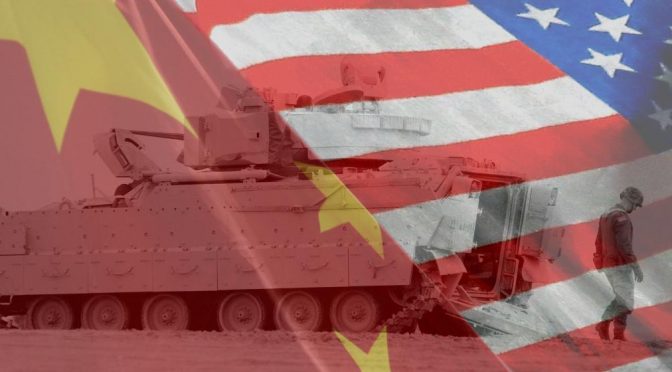Poyer, David. Onslaught: The War With China – The Opening Battle. New York City, St. Martin’s Press, 2016, 320 pp. $20.99
 By Michael DeBoer
By Michael DeBoer
When I was in high school I was walking through a Borders (I know this dates me) when a book caught my eye. Its cover featured a small ship, photographed from directly above, in a sea of red. The book was China Sea, and when I read it, I made a lifelong friend. I’ve followed David Poyer’s character, CAPT Daniel Lenson, from his junior officer tour to the present series of novels of his major command, starting with The Cruiser published in 2014. Lenson’s integrity and competence was a part of my inspiration to accept an appointment to the Naval Academy when I was an enlisted Sonarman, and his stories provided me some measure of context when I was there and later, as I read the books through my career. In short, I’ve loved following Dan Lenson’s career and I’ll miss him when he is gone.
Poyer’s stories feature a mix of the high drama and the cold technical nature of combat at sea. In that aspect the author’s latest story, Onslaught, is an excellent contribution to the series, I would argue one of the most notable collections of sea literature of the modern era. Fans of the series will find old friends inside, while new readers will discover a set of strong, relatable characters: Teddy Oberg, Poyer’s Navy SEAL, Aisha Ar-Rahim, NCIS Special Agent, ADM Jung, South Korean Navy commander, Cheryl Staurlakis, indefatigable XO, Matt Mills, ultra-competent Ops Officer, and Amy Singhe, impertinent upstart JO, are all back. Poyer’s characters are believable and rich, with complex motivations and deep emotions. Moreover, all are strongly affected by events around them. In Poyer’s typical fashion, the work features four concurrent stories: Lenson’s command of USS Savo Island on an ASW barrier in the Miyako Gap, Special Agent Aisha Ar-Rahim’s investigation of a violent rapist onboard Savo, SOCM Teddy Oberg’s assault on Woody Island, and Lenson’s wife Blair’s participation in strategic planning for the coming war with China at SAIC. These four stories are interspersed with the searing exhaustion that only members of the sea services can recognize as an authentic portion of Navy life.
Poyer’s Onslaught describes where many think the series was always headed: an all-out war with the People’s Republic of China. However, despite my expectations that the book would take off into ultra-intense combat immediately, the novel instead features the slow burn of increasing tensions and asymmetric tactics. Lenson’s Savo Island heads a surface action group on ASW station in the East China Sea attempting to hold against attempts by PRC submarines to gain the Philippine Sea while providing missile defense to Taipei. Lenson’s Savo, a notional Ballistic Missile Defense (BMD) configured cruiser, allows the author to write rich and genuine series of combat. Only Poyer’s shootout in the Strait of Hormuz during Tipping Point exceeds the vignettes in this book. Moreover, the author’s depiction of BMD operations makes a complex and often arcane art easily accessible and exciting.
Poyer’s story features many operational considerations familiar to CIMSEC readers. The ballistic missile barrage across the Taiwan Strait, PRC aggression in the South and East China Seas, Anti-ship Ballistic Missiles, and a U.S. Navy struggling to maintain access to the East Asian littoral remain the major security issues of our time. Moreover, lack of ASCM inventory, of launcher capacity, and the vulnerability of multi-mission ships when operating in a BMD role are tactical issues well known to U.S. naval planners.
Onslaught, like Poyer’s previous book Tipping Point, has an air of the coming of a cataclysm. Images of the Guns of August abound, as do instances reminiscent of the Solomon Islands and Sunda Strait. Poyer clearly fits the difficult portions of America’s last naval war in Asia, entirely forgotten by the American public and largely ignored by the strategic community, into his narrative. The result is a sense of high tension and intense foreboding.
If I could provide a slight criticism, Special Agent Ar-Rahim is at times irritating. She remains the worst developed Poyer character and contributed little to the story. Aisha can, at times, who at times comes off as more of a caricature than an actual person, though Poyer’s effort to convey diverse viewpoints is indeed commendable and usually very effective.
Poyer’s work should be strongly recommended by CIMSEC readers, especially to friends who may not understand both the complexity, tension, feeling, and exhaustion of combat at sea. In an era where many question the value of allies, the importance of forward naval forces, and likelihood of great power war, Onslaught provides a stunning and believable narrative of the importance of all three. The pace is fast, the combat visceral, and the emotions intense. Poyer remains one of our modern masters of nautical fiction and the emotions of war at sea. Tipping Point and Onslaught are strongly recommended to anyone who is interested in potential conflict with a hegemonic China, loves a good story, or lives their professional life at sea.
Read CIMSEC’s interview with author David Poyer here.
Michael DeBoer is part of the CIMSEC book review team.
Featured Image: Illustration by Sarah Eberspacher. (Getty Images)

